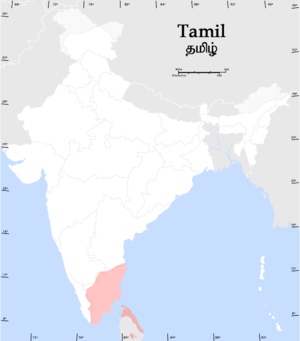Èdè Tàmil
Ìrísí
| Tamizh | ||||||
|---|---|---|---|---|---|---|
| தமிழ் tamiḻ | ||||||
| Ìpè | IPA: [t̪ɐmɨɻ] | |||||
| Sísọ ní | India, Sri Lanka and Singapore, where it has official status; with significant minorities in Canada, Malaysia, Mauritius, and Réunion, and emigrant communities around the world.[1] | |||||
| Ìye àwọn afisọ̀rọ̀ | 66 million native[2] | |||||
| Èdè ìbátan | ||||||
| Sístẹ́mù ìkọ | Tamil script | |||||
| Lílò bíi oníbiṣẹ́ | ||||||
| Àkóso lọ́wọ́ | Kòsí àkóso oníbiṣẹ́ | |||||
| Àwọn àmìọ̀rọ̀ èdè | ||||||
| ISO 639-1 | ta | |||||
| ISO 639-2 | tam | |||||
| ISO 639-3 | tam | |||||
 | ||||||
| ||||||
Tamil (தமிழ் tamiḻ; [t̪ɐmɨɻ] ![]() (ìrànwọ́·info)) je ede Drafidi ti awon Tamil n so.
(ìrànwọ́·info)) je ede Drafidi ti awon Tamil n so.

|
Àyọkà yìí tàbí apá rẹ̀ únfẹ́ àtúnṣe sí. Ẹ le fẹ̀ jù báyìí lọ tàbí kí ẹ ṣàtúnṣe rẹ̀ lọ́nà tí yíò mu kúnrẹ́rẹ́. Ẹ ran Wikipedia lọ́wọ́ láti fẹ̀ẹ́ jù báyìí lọ. |
Itokasi
[àtúnṣe | àtúnṣe àmìọ̀rọ̀]- ↑ Àṣìṣe ìtọ́kasí: Invalid
<ref>tag; no text was provided for refs namedethnologue2005 - ↑ "Languages Spoken by More Than 10 Million People". MSN Encarta. Archived from the original on 2007-03-04. Retrieved 2007-04-02.
- ↑ "Official languages". UNESCO. Retrieved 2007-05-10.
- ↑ "Official languages of Tamilnadu". Tamilnadu Government. Retrieved 2007-05-01.
- ↑ "Official languages of Srilanka". State department, US. Retrieved 2007-05-01.
- ↑ "Official languages and national language". Constitution of the Republic of Singapore. Government of Singapore. Archived from the original on 2015-09-24. Retrieved 2008-04-22.

